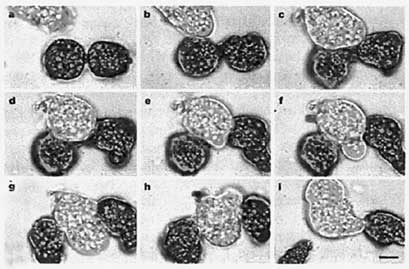
Consciousness is at the very heart of beings and things -- the heart that is nowhere in particular because it is everywhere. Armed only with daily newspaper information, curious human beings' first considerations of consciousness could range in scale from cosmic superclusters to subatomic entities. Dr. Leon R. Kass, professor of philosophy and ethics at the University of Chicago and President Bush's adviser on bioethics, "refers in his writings to the soul, a word he uses in a nontheological sense to mean that a living organism, even a bacterium, is not just a collection of molecules but a thing with needs, awareness, desires and goal-directed activities" (New York Times Science, Tuesday, March 19, 2002). Or as Dr. Seuss' Horton says, "After all, a person's a person. No matter how small."
For the scientist to observe and measure beings and things, he has first to outline the entities that live in the spaces of space. One such outline of consciousness concerns the one-celled animalcules we call amoebas. The root meaning of this word is "constantly changing." With the invention of the microscope near the end of the 17th century, the heretofore invisible was observed as an ever-changing entity involved in the activity of life, i.e., interacting, engulfing food, reproducing, etc.
Under the heading "Amoeba 'Midwives' Found to Assist in Reproductive Process," the March 22nd Los Angeles Times reported that
Giving birth is never easy, and potential mothers often need help from a midwife. New research suggests that the rule extends even to amoebas . . . that reproduce by splitting apart into mother and daughter cells. Researchers have previously noted that, at least in one species, this process often stalls while the two cells are still connected by a slender thread -- and they were unsure how the cells completed the process. Biophysicist Elisha Moses and his colleagues at the Weizmann Institute in Rehovot, Israel, report in today's Nature that they are assisted by a "midwife" amoeba that gets between the separating cells and pushes them apart until the thread breaks. The stalled amoebae emit a chemical cry for help that attracts the midwife, the team said. -- "Science File," Metro, p. 2
The original story in Nature describes further this "surprising example of primitive cooperation":
When an amoeba divides, the two daughter cells stay attached by a tubular tether which remains intact unless mechanically severed. If called upon, the neighbouring amoeba midwife (color cell in figure above) travels . . . towards the dividing amoeba, usually advancing in a straight trajectory. . . . The midwife then proceeds to rupture the connection, after which all three amoebae move on. -- Vol. 410, 22 March 2001; supplementary information available on Nature's website at www.nature.com
On the microscopic scale, consciousness' cooperation and perceptive compassion insinuates that on the macroscopic or human scale the same holds true, as with the ancient and universal midwifery statement: "When the student is ready, the teacher appears." Then all three entities move on -- the old self, the new self, and the midwife -- carrying the experience that will teach others. -- Wynn Wolfe
(From Sunrise magazine, June/July 2002; copyright © 2002 Theosophical University Press)
As soon as a true thought has entered our mind, it gives a light which makes us see a crowd of other objects which we have never perceived before. -- Chateaubriand